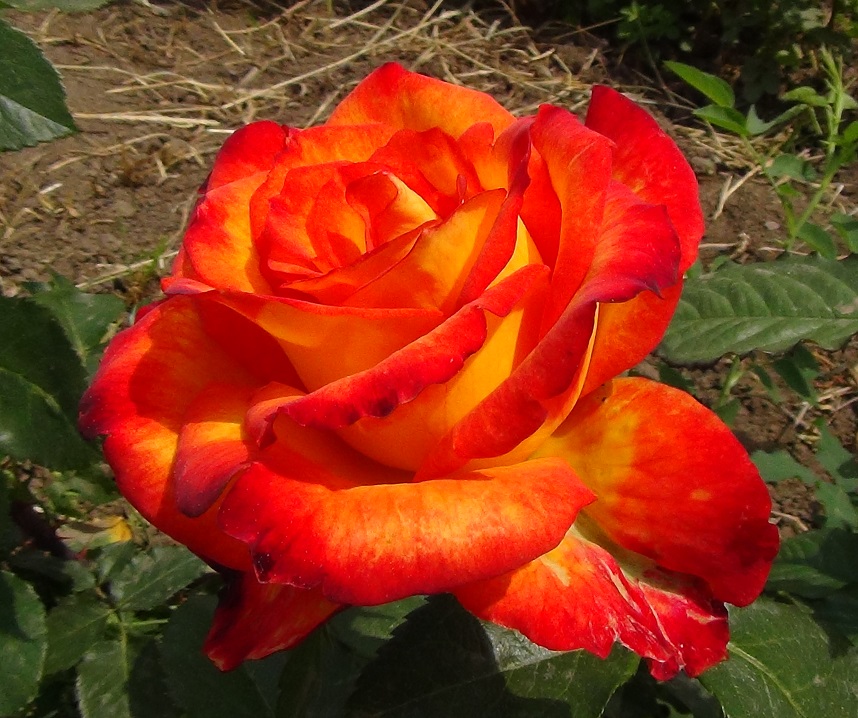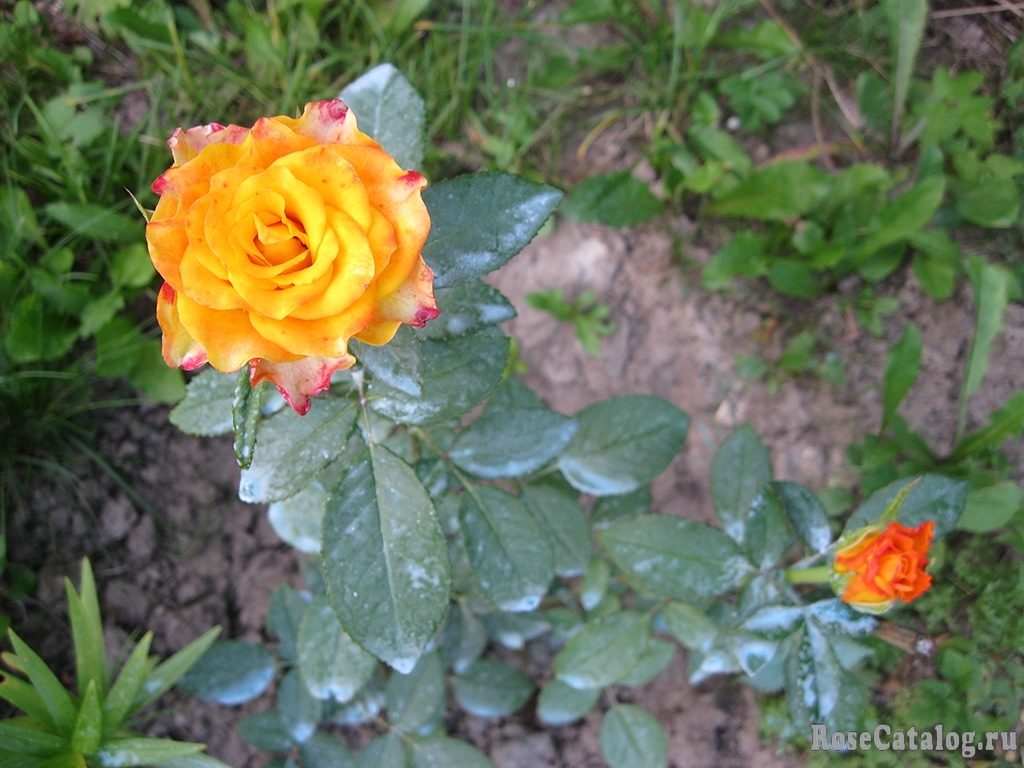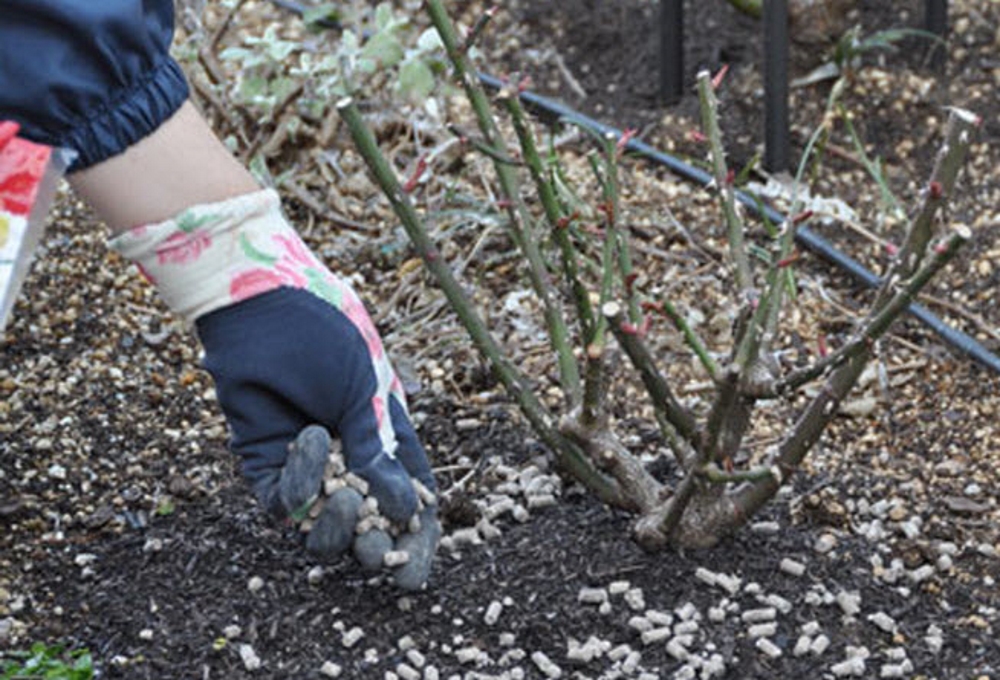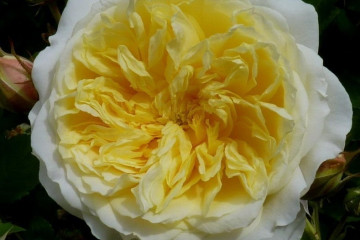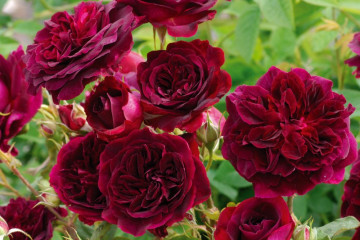Rose Circus (Circus) - characteristics of a varietal plant
Content:
Roses are one of the most sought-after and beautiful flowers. Among all the splendor of varieties, the most popular variety is Circus. Consider what kind of variety it is and its features.
Rose Circus (Circus) - what is this variety, history of creation
Rosa Circus is a prominent representative of the floribunda group. This hybrid was developed in 1956. Despite the fact that Circus has several types of mutations, the original flower shape is hard not to recognize. Rosa Circus is a short bush with dark green foliage that covers the entire plant. The flower bud has a honey-yellow color in the center and red-pink at the edges.
Rose: Circus variety
Description of the Circus rose in the table.
| Name | Characteristics of the rose Circus |
| Flower shape | Large, rounded, cupped |
| Bud size | 7-8 cm |
| Number of petals | about 40-45 |
| Bush height | 50-70 cm |
| Bush width | up to 100 cm |
| Smell | Light, pleasant aroma characteristic of roses |
| Foliage | Fine, shiny, thick |
| Thorns | Large, in small quantities |
Due to its unpretentiousness, the plant is suitable for growing in all regions of Russia. Compared to other roses, Circus has the following advantages:
- abundant, lush flowering of one bush;
- flowering continues throughout the season and lasts until the very frost;
- easy to grow, care for;
- high endurance to various weather influences;
- moisture resistant, perfectly tolerates rainy weather, dew;
- winter hardy.
Despite its unpretentiousness, the variety in question has some disadvantages inherent in most flowers. Among them are:
- weak aroma of flowers;
- poor development in cold regions.
The Circus rose is undersized, its height does not exceed one meter. In this case, the bush is quite lush. One such bush has about 3-11 buds. Due to these properties, Circus is often used in landscape design. They are placed along curbs, paths, sidewalks, used in flower bed decoration, etc. Circus is considered a versatile plant, as it is used in many decorative elements and compositions.
Growing a flower, how to plant it in open ground
Like most roses, the Floribunda Circus rose does not differ from them and is propagated mainly by seedlings. For planting this variety, they choose a warm sunny area, preferably where cold winds and drafts will not be affected. Rose prefers loose, non-acidic and fertile soil. In this case, the acidity of the soil should be about 5.6-7.3 pH.
The landing pit is pre-prepared. The roots of the rose in the hole should be free. For this, depressions with a size of at least 50 cm are suitable. A drainage consisting of gravel and sand is also formed in it. This is done so that stagnation of water does not occur later. Otherwise, the roots may rot.
It is recommended to form the soil mixture in the planting pit as follows: three parts of manure, two parts of black soil or other fertile soil, two parts of sand and one part of peat. This mixture will allow the rose to take root faster and develop well in the future.
Landing is done in the usual way. The period depends on the region in which you plan to grow Circus. In regions with a warm climate, plants are planted either in early spring or closer to autumn. In cold weather - in late spring, closer to summer. The best time for planting in most regions is the beginning of May. By this time, the soil is warming up and is ready to receive the seedlings.
The procedure for planting a rose hybrid tea circus is as follows:
- just before moving the seedlings into the soil, they need to be kept in water for a while. This “soaking” procedure will allow the rose to take root better. They are soaked for 4-6 hours in clean, settled water. In this case, the water temperature must correspond to the ambient temperature. The soaking container should be spacious so that the roots are free to sit and not bend;
- damaged roots and shoots are removed, weak ones are pruned, too long are slightly shortened. Leave strong roots of an average length of about 10-20 cm. The cuts should be carried out at an angle of 45 ° C;
- prepare a pit (the process of preparing a planting pit was described above) and begin planting a rose in the soil;
- the seedling is placed in the pit so that the roots are in a free state, do not break or bend. The grafting site should be about 5 cm below the soil surface;
- the seedling is gradually covered with soil mixture, in small portions. It is important that all the voids between the roots are well, but not too densely filled;
- filling the planting hole, lightly tamp the soil surface with your hand.
Plant care
The established Circus seedlings subsequently require care. It is important to feed, water and weed them regularly. Weed the soil if necessary, as soon as a fresh weed has sprung up.
Watering the rose
The roses are watered abundantly. Lack of moisture can have a strong effect on roses, but frequent watering in small amounts can also harm them. Therefore, the optimal watering is once a week. In extremely hot, dry weather, the amount of watering can be increased to 2-3 per week. For one such watering, about 5 liters of water should be spent, no more. In rainy weather, the amount of watering is reduced.
Under optimal weather conditions, Circus is watered as follows:
- small depressions, grooves or holes are made around each bush;
- pour them abundantly with water;
- one bush should take about 15 liters of water;
- after watering, the grooves are added dropwise;
- the soil is loosened with a deepening of up to 10 cm.
Roses are watered either early in the morning or late in the evening. It is desirable that before nightfall the foliage of the Circus has time to dry from moisture.
Top dressing and soil quality
Roses are fed with complex fertilizers, which can be purchased in specialized stores, or with "home" dressings. Circus feed can be used:
- organic;
- mineral;
- organo-mineral;
- natural, such as manure, ash, peat, compost, etc.
Basic rules for feeding Circus:
- before feeding, as well as after it, the soil is poured abundantly. Thus, an excessive amount of salts and substances, which are contained in large quantities in fertilizers, will not get to the rose;
- in the spring, fertilizers are applied before the growth of buds and shoots begins;
- in the summer, the soil under the plant is fertilized twice - before the buds begin to form and during the period of abundant flowering;
- in the fall after the growing season, roses are also fed with fertilizers;
- after fertilizing and watering, the soil under the bushes is loosened.
Pruning and replanting
Pruning of seedlings is carried out only during spring planting. When planting in autumn, the plants are not pruned. Firstly, because the young shoots that form after pruning do not have time to ripen before winter and die. Secondly, most gardeners use autumn pruning only to make the plants easier to cover in winter.
It is recommended to transplant Circus rose seedlings in autumn, from September to October. They begin to dig up a rose for transplanting from the very edge, gradually approaching the middle. The root root of a rose goes quite deep, so in some cases you just need to chop it off for further transplantation. The soil that remains at the root should not be cleaned, the rose is transplanted to another place right with it. You can transfer a rose from one place to another with a tarp or strong oilcloth. The process of planting a dug out seedling does not differ from the process of planting a young plant, which was mentioned at the beginning of the article.
Features of wintering a flower
An important feature when preparing Circus for wintering is to prepare the soil. The soil under the flower must be dry. For this purpose, closer to September, experienced gardeners stop watering roses altogether. If the summer was rainy, then they stop watering already in mid-August.
Before wintering, the foliage is removed. By the first half of November, perennials, as well as excess shoots, are cut off, and the soil under the bush is loosened to a depth of 10 cm. Circus is covered in different ways. Of course, the quality and basis of the shelter depends on the landing region. In warmer climates, peat with a mound of about 20 cm above the surface or a layer of leaves with hilling can be used for shelter. In cold regions, shelter structures are more serious - from spruce shelters to special non-woven fibrous materials, for example, lutrasil, which withstands low temperatures and does not damage the plant.
Blooming rose
The active flowering of Circus occurs in June and August.
The dormant period of Circus from flowering can also be observed in the following cases:
- in the first year of planting seedlings. It all depends on the condition of the seedling, its care.
- wrong landing site;
- incorrect pruning in spring or autumn;
- care for Circus was performed incorrectly - lack of feeding, excessive watering, or vice versa, etc.;
- old roses.
Here are the main reasons why a rose may not bloom.
Flower propagation
There are quite a few ways to reproduce Circus, among which cuttings are the most common. It is worth cutting a rose at the beginning of summer, and the easiest way to do this is in the garden itself. During the flowering period, roses from lignified shoots form cuttings, which are immediately buried in the ground next to the main bush in order for them to take root.
The rose is also propagated by dividing the bushes, which is typical for Circus. The division of the rose is carried out in early spring - before the buds are formed. The roots and places of damage to the rose, which were formed during division, are treated with a special mixture of manure and clay.This mixture heals and allows the old and new plant to take root.
Another way of reproduction is by layering. A mature, but not yet flexible shoot is selected and a circular incision is made in the bark approximately 8 cm long on the side that will be immersed in the ground. Layers are propagated in spring or mid-summer.
Transplanting offspring is another way to breed roses. Most simple, but less effective. The offspring are separated and transplanted to a new place in the spring, when the ground has already thawed.
Diseases, pests and ways to control them
Like any other plant, pests appear on Circus sooner or later, or it is affected by diseases. Among the most common:
- powdery mildew;
- black spot;
- rust;
- gray rot;
- spider mite, etc.
In order to eliminate pests and diseases in roses, damaged leaves, flowers, shoots are removed. The second step will be spraying with a specialized solution. For each type of pest, an individual control method is selected. For example, to get rid of black spot, use a one percent solution of Bordeaux liquid or a decoction of nettle.
Hybrid rose Circus is one of the most beautiful and sought after. Caring for it does not require special skills, so everyone can grow such a plant.
